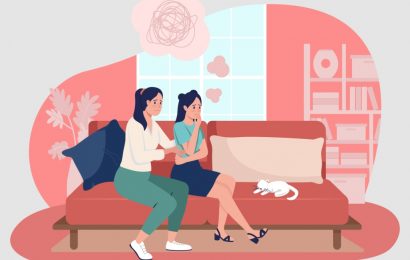- Some videos about family members hugging for the first time since the pandemic started have been going viral, clearly touching a nerve.
- In light of this, the New York Times spoke with scientists to ask them how to minimize risk while hugging.
- They created illustrations to show the safest ways to hug. Recommendations include wearing a face mask, not talking, and keeping them short to further reduce the risk of spreading the novel coronavirus via hugging.
Hugs have been a big part of showing you care since practically forever, but they’ve unofficially been banned among people outside the same household ever since the COVID-19 pandemic started. But when hugs have happened—and captured on video—those videos have swept the internet up in its warm embrace. For example, a Canadian woman created a “hug glove” out of a clear plastic tarp–with sleeves—so she could hug her mom. The video of their hug has been viewed nearly 24,000 times on YouTube.
But if you don’t have a “hug glove,” there’s still a safe (or mostly safe) way to get your hug on these days.
The New York Times spoke to scientists who study airborne viruses to ask them how to safely hug in the era of COVID-19. Among other people, The Times reporter Tara Parker-Pope spoke to Linsey Marr, an aerosol scientist at Virginia Tech and one of the world’s leading experts on airborne disease transmission, about the risk of contracting a virus during a hug. Marr analyzed mathematical models from a study that shows how respiratory viruses travel when you’re close to someone and found that your risk of exposure during a short hug is pretty low.
That’s especially true if you’re a silent hugger. “If you don’t talk or cough while hugging, the risk should be very low,” Marr told the publication. Holding your breath while you hug can also help, Julian Tang, a virologist and associate professor at the University of Leicester in England who studies how respiratory viruses travel through the air, added to The Times.
But there are different things you can do to reduce the risk of hugging even further. Eleni Kalorkoti, the illustrator for the piece, broke down the tips in simple terms and easy-to-replicate illustrations:
https://www.instagram.com/p/CBDYXHgsckS/
- Don’t hug face to face
- Don’t hug cheeks together, facing the same direction
- Do hug in opposite-facing directions
- Do let your children hug you around the knees or waist
- Do kiss your grandchild on the back of the head
A hug seems like a simple thing, but it can be a BFD. Physical affection helps reduces stress by calming your sympathetic nervous system (and your sympathetic nervous releases stress hormones into your body), according to research.
In fact, Candice Hargons, PhD, director of the Center for Healing Racial Trauma, recommends hugging people more often as a way to maintain and preserve your mental health while combating systemic racism and social injustice. This is true for everyone, but especially for black Americans. The physical touch promotes wellness and a hug or friendly touch can increase the release of the oxytocin hormone, which can help reduce your stress response and general anxiety during difficult times.
So, go ahead and hug somebody. Maybe just hold your breath while you do it.
Source: Read Full Article


